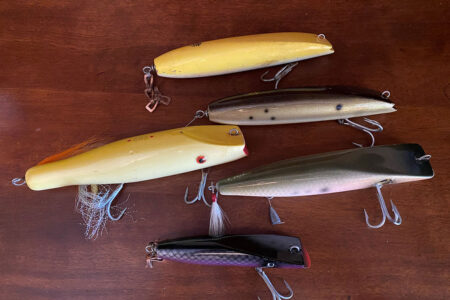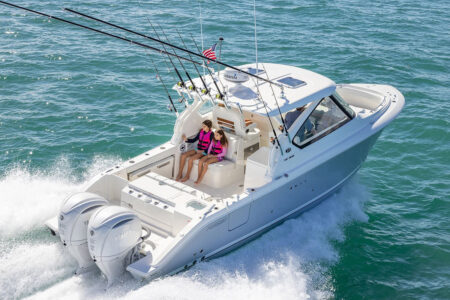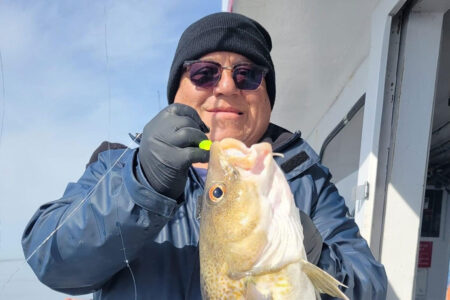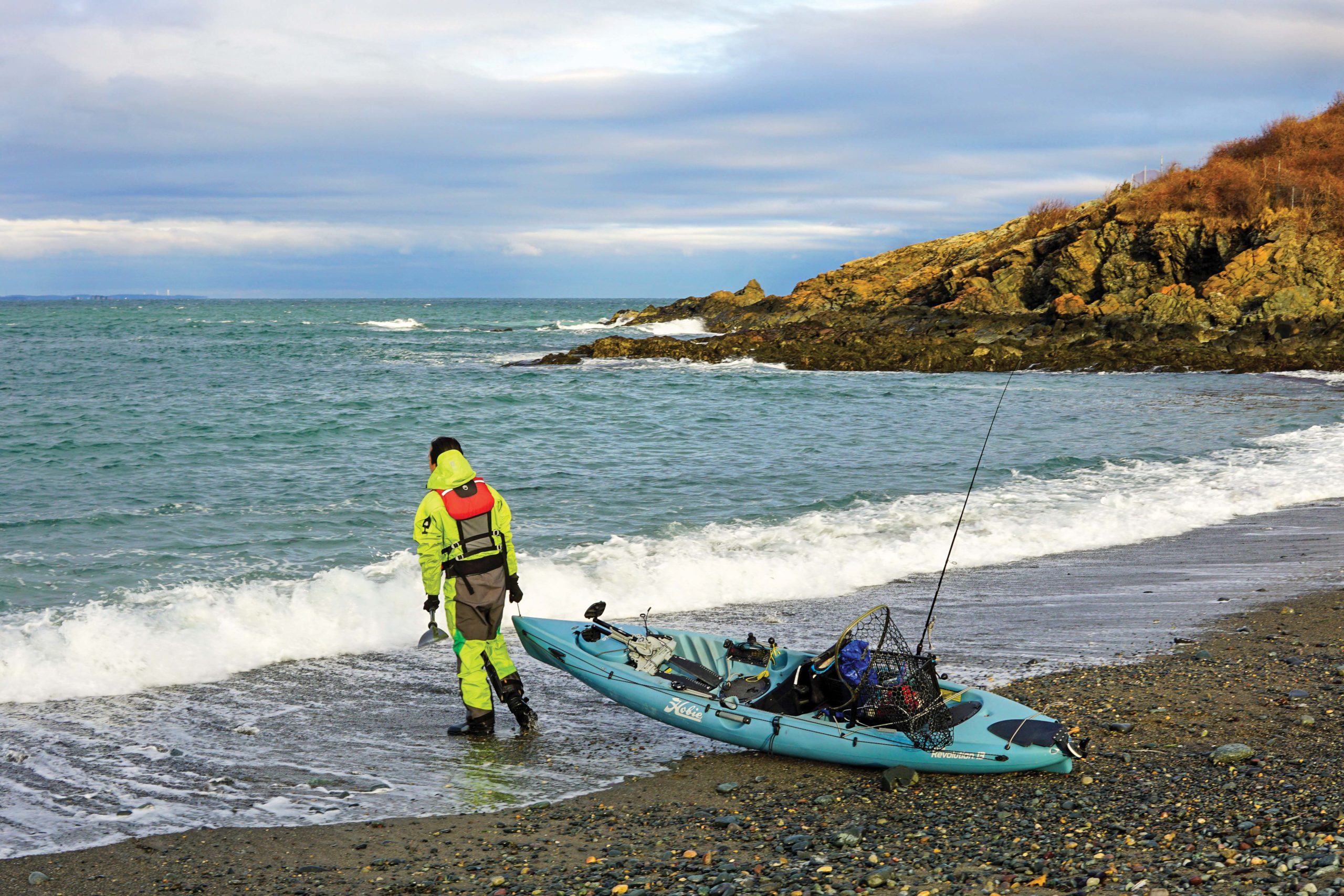
What you need to know about kayaking in the cold.
What drives a person to kayak fish through the winter? Is it the lights out fishing? Or the quality of the fish biting? Well, probably not. Although quality and quantity can be found, it probably has more to do with the love of the process. As the seasons change, much fishing stays the same: scouting charts, prepping gear, keeping detailed logs. The joy that each of those steps brings me is well worth the physical challenge of kayaking in cold water. As a bonus, the efforts made during the offseason translate into fishing success during the warmer months. Give it a shot. You don’t need to jump right into winter kayak fishing, but try starting your spring season early.
There are lots of advantages: you’ll have access to tog structures that haven’t seen pressure in months, targeting holdover stripers keeps your technique sharp, and most importantly, you’ll be honing your ability to locate and catch fish while the biomass is low and lethargic—a valuable skill any time of the year. Before you get started, you need to get prepared. Coldwater kayaking poses some risks, and extra precautions need to be taken in water temperatures below 60 degrees.
Gear Essentials
There are three pieces of equipment that I consider to be necessary for cold-water kayak fishing: a VHF marine radio, a personal flotation device (PDF), and immersion gear. The first two should be a given year-round, but they become essential as the water temps fall. Immersion gear, either a wetsuit or a drysuit, becomes relevant when the water temperatures drop. I’m putting this section first because equipping yourself properly can save your life. Data from UMN’s Sea Grant shows that at a water temperature of 50 degrees, a typical person will become exhausted or unconscious in about one hour without a PFD or immersion gear. With flotation, you push your survival time to three hours. Adding appropriate immersion gear extends your survival time to 12 hours in the water.
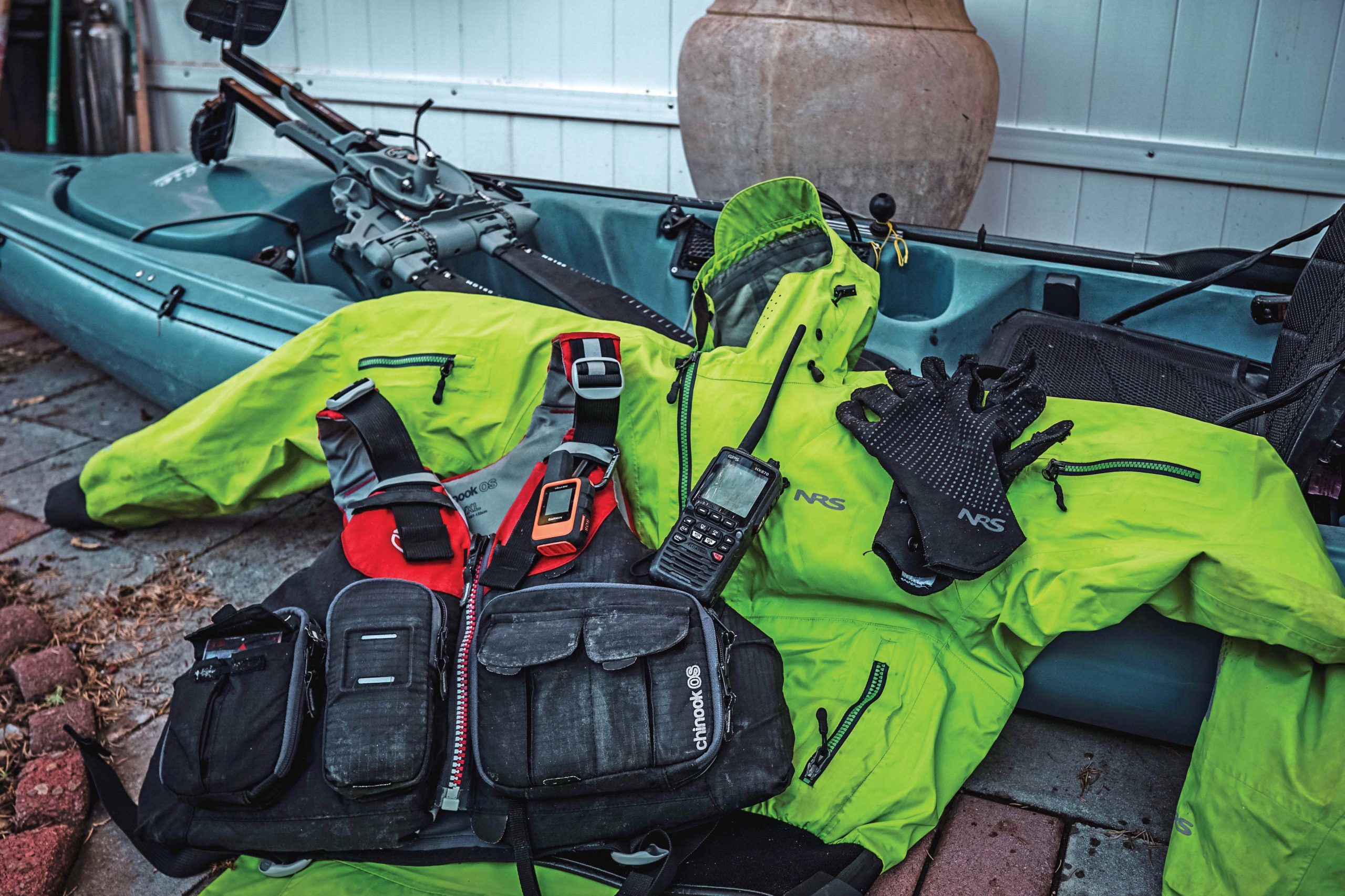
Drysuit vs. Wetsuit
Kayakers looking to acquire immersion gear are faced with a hard decision: drysuit or wetsuit? It’s a hotly debated topic, but ultimately there is no correct answer. Each offers its distinctive pros and cons, and depending on the type of fishing you do, one might suit your needs better than the other. A wetsuit is an excellent option for someone looking to extend their kayak season by about a month into the late fall and early spring. For this purpose, a 5/3 or a 4/3 wetsuit fits the bill. What makes the wetsuit such a great option is the accessibility. A wetsuit might be standard gear for many kayak fishermen who also fish the surf. For the rest, a wetsuit can be bought for around $200. In situations like re-entry or swimming to shore in an emergency situation, the next-to-skin wetsuit creates a lot less drag than a baggy drysuit in the water. However, when you’re happily sitting on top of your kayak instead of scrambling to get back in, wetsuits are not very breathable and can feel restrictive.
Drysuits are comfortable because they are, in essence, a watertight shell around your everyday clothes. You get to move freely while staying completely dry. This is a considerable advantage if your access points require getting in the water to launch your kayak. Especially for those launching through the surf, not having to fish in a soaking wetsuit is a huge perk. Another factor contributing to the comfort of a drysuit is its adaptability; you can dial in your insulation underneath and be comfortable in a wide range of temperatures. When the air is warm but the water is cold, I pair a breathable fleece jacket under my drysuit and don’t have issues with overheating or moisture buildup in temperatures up to 70 degrees. As the temperatures drop, layers can be added without sacrificing comfort. Because of this, one drysuit can fill the temperature ranges of two or even three wetsuits. I bring that up because I’m about to mention the biggest con: the price. While some drysuits can be found for as “low” as $400, most will run you between $600 and $1,000. The higher-priced ones offer improvements in durability and breathability and tend to have better repair service. Although they are expensive, some anglers find a lot of value in a piece of equipment that allows them to kayak fish for an extra six months of the year (about November to May on Long Island).
To summarize, wetsuits are a great option if you’re an angler looking to extend their kayak fishing season by a month in the spring and fall (not the winter). They’re also a lot more affordable. The biggest trade-off is heat management and comfort. Consider a drysuit if you want to be able to own one piece of immersion gear and fish year-round or launch in areas where you will get wet. Just know, you’re going to pay for that luxury.
PFD’s By The Numbers
A Type III PFD is a good balance between safety and functionality for kayak fishing. They don’t interfere when working your rod close to your body and allow you to properly lay your back on your seat. I also carry my radio and a knife in my PFD. Those are two things you’ll want with you if your kayak rolls. Make sure your knife is sharp and can cut any gear leash that could tangle you. Attach a strobe light if you plan on fishing in the dark.
There are also two other main types of PFDs if you’re willing to sacrifice some comfort for more safety which is not recommended. Type I PFDs are designed to keep your mouth above rough water, even if you are unconscious. Type IIs do the same but in calmer water. In contrast, you can’t rely on a Type III PFD to flip you while unconscious. They offer the same amount of flotation as a Type II. For most inshore anglers, this feature isn’t necessary.
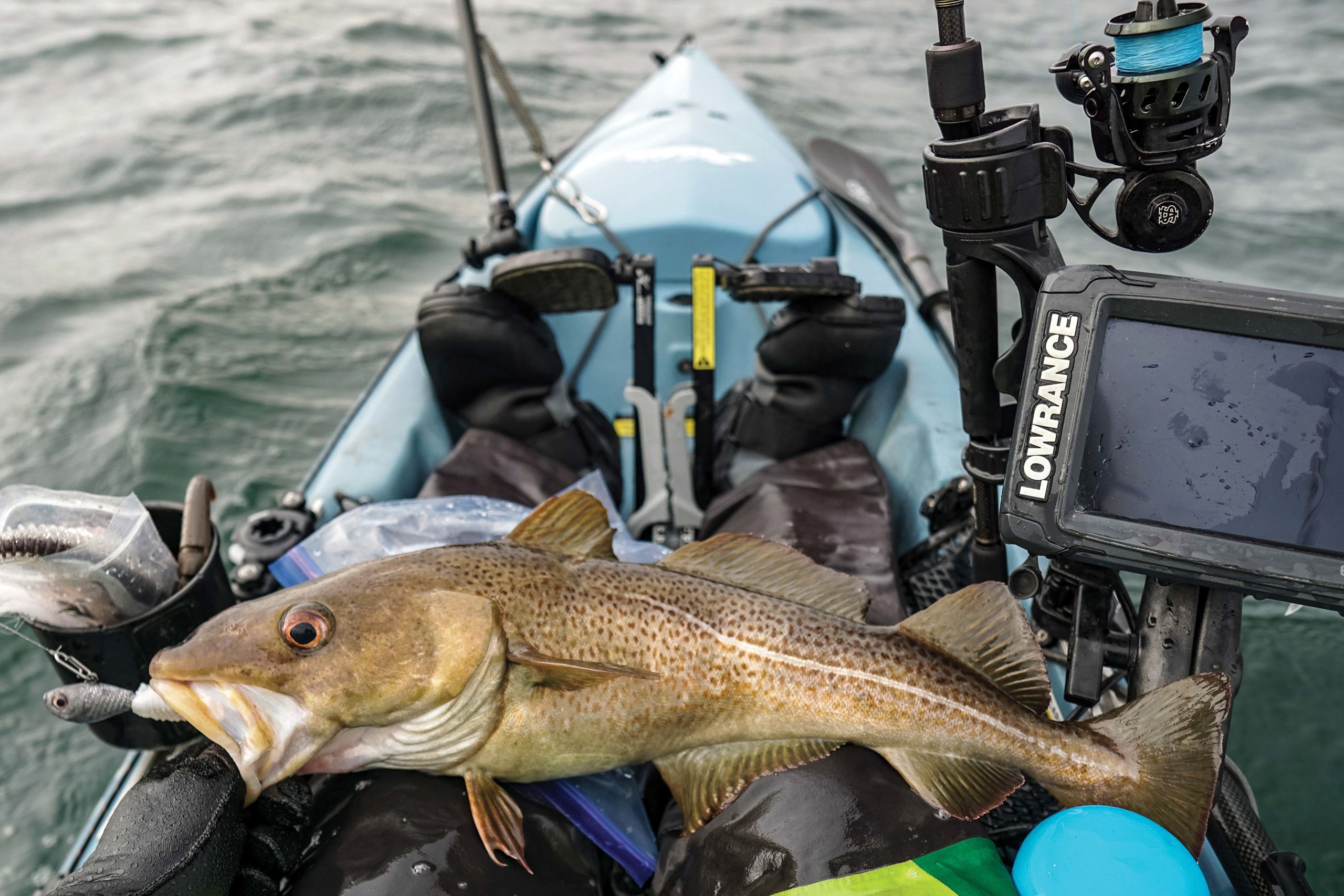
Comfort Items
Your core might be well-insulated under your immersion gear, but cold air takes a toll on your hands and face. I keep my hands insulated with a pair of 3 mm neoprene gloves. They still get cold, but I stick with 3 mm because it maintains a good balance between warmth and dexterity. I’ll also always keep a few hand warmers in a drybag if I need a burst of heat. For my face, a thin breathable covering like a Buff is enough to keep me warm in most cases. For those in drysuits, don’t neglect your leg insulation. If I pay attention to why I feel cold on a fishing trip, it’s usually my legs. Your core gets fleece and down jackets. Legs typically don’t get the same treatment. My fix was to put on as many pants as I could find. I’ve worn 4 to 5 pairs of sweats, pants, and base layers at once just to stay warm. After a recent ski trip to Vermont, I became inspired to wear insulated ski pants under my drysuit instead. Give it a shot when the air temperatures are around 40; you’ll notice a big difference in reduced bulk and overall warmth.
Safety Checklist
Equipment is just one part of staying safe on the water. Here are a few essential things you should do before your first cold-water trip. Practice self-rescues on your kayak even if you’ve done them before. Self-rescue is more difficult with immersion gear, creating drag and cold water fatiguing your muscles. Become comfortable with the movements because it’s crucial to get back in your kayak in the cold. Secondly, make sure your VHF radio is working. I recommend doing a DSC test call to the USCG group identity “003669999”. If the test call receives an acknowledgment from the station, you’ll know that your radio can send out a DSC distress call. Lastly, tell someone where you will be fishing and when you expect to be back before every trip.
The Right Conditions
I’m much less willing to go out in rough conditions when the water is cold. There’s no magic number for the maximum safe wind speed, but subtracting five knots from the winds you feel comfortable fishing in during the warmer months is an excellent place to start. For example, if your upper limit of comfort is 15-knot sustained winds in the summer, find windows where the average is below 10. I prefer gusts when they are no more than 5 knots higher than the sustained wind speed.
Other factors like swells, wind direction, and current are also important. Again, understand what you are comfortable with normally and play it slightly safer. If there is going to be some wind, check its direction to predict if wind-over-tide conditions will cause chop. Following seas and offshore wind can also make kayaking more difficult. I try to stay above 38 degrees when it comes to water temperature. Any lower and I’m concerned that I could get hypothermia relatively quickly even in my drysuit and layered insulation. Once you’ve identified a day where you’re comfortable with the conditions, check that date on multiple forecasts. I use the apps Clime-NOAA Weather Radar, Windy, and Windfinder on my phone and iPad. If the forecasts match, all that’s left is waiting and hoping they don’t change by the time you’re on the water.
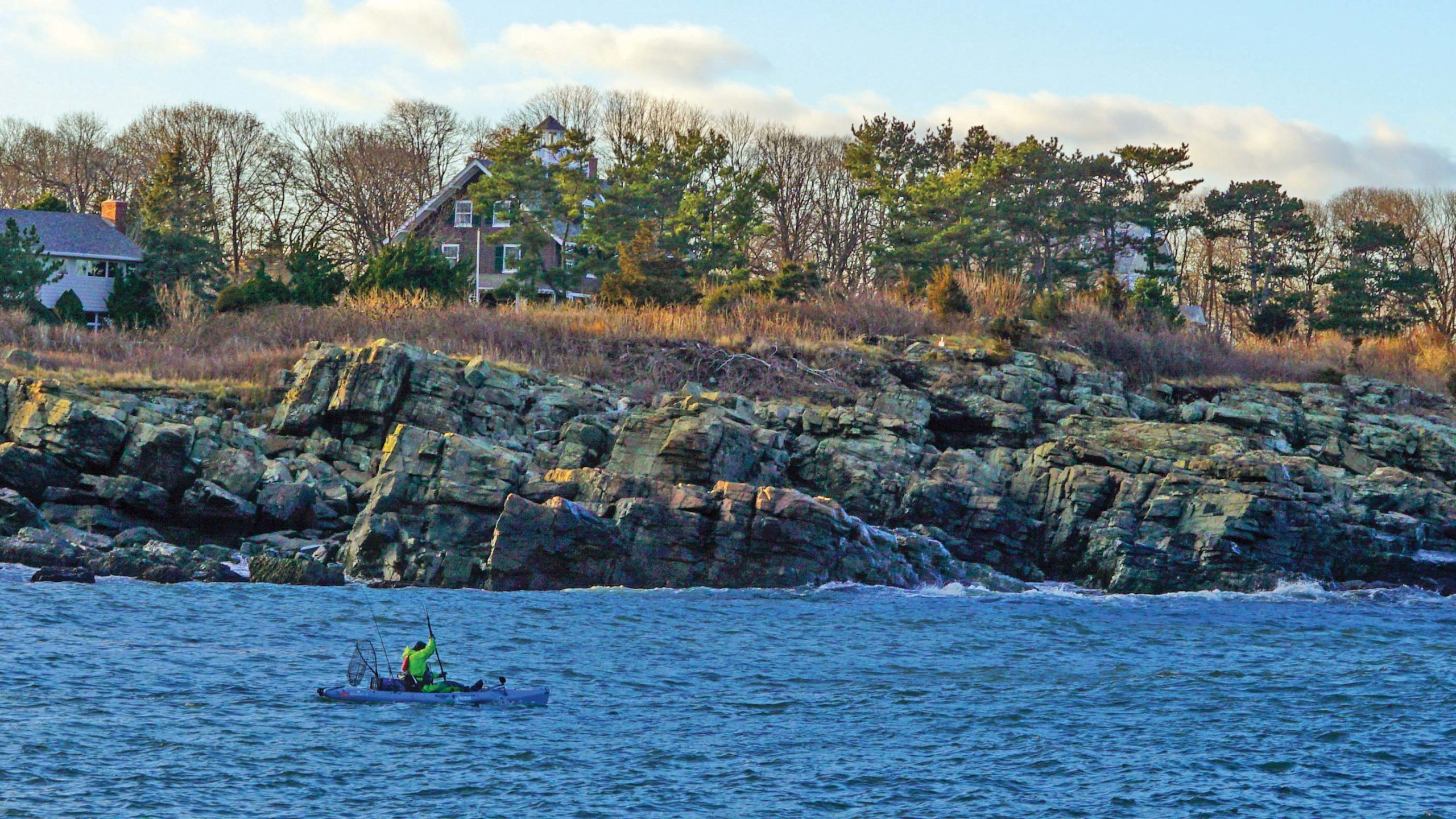
A Good Day On The Water
So you’ve got your gear essentials, prepared all your safety precautions, and even have a weather window. Now it’s time to have a good day on the water. For me, it doesn’t take much to consider a trip successful this time of year. Because of the lower biomass of fish, any trip where I learn something valuable for the season ahead is successful.
My kayak fishing primary focus between December and April is to learn about my local waters rather than to catch the most fish. It’s a great time to go into your charts, find some interesting features, and scout the area in person. On my next trip, I’m hoping to scout a potential white perch honey hole to put in my log for a later date. This process has been a great way to build my repertoire of GPS waypoints in my home waters. I hope you’ve been convinced to give cold-water kayak fishing a try. Now is a great time to prepare for it if you are. Please stay safe and I hope to see you on the water!
